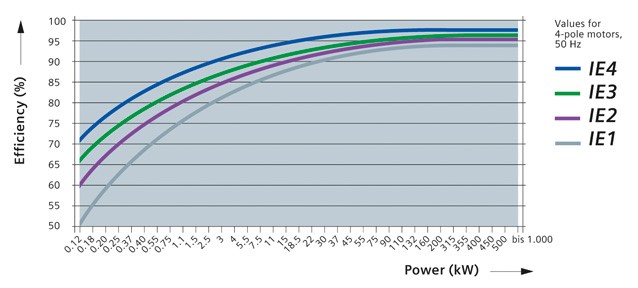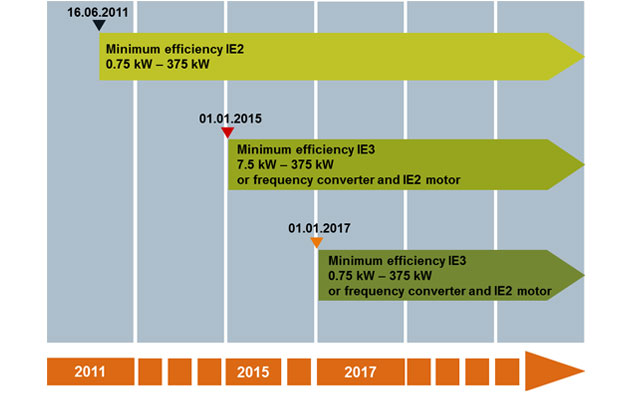Services
Efficiency Classes For IEC Motors

Standard IEC Line Motors (IEC 60034-30-1)
In March 2014 the standard IEC 60034-30-1 has been published. It replaces the standard IEC 60034-30:2008, which has defined three efficiency levels for three-phase induction motors to date. The updated standard IEC 60034-30-1 now includes the fourth efficiency level IE4. Furthermore 8-pole motors and an extended power range are now included in the standard.
Efficiency classes
In the IEC 60034-30-1 the following efficiency classes are defined for induction motors (IE = International Efficiency :
- IE1 (Standard Efficiency)
- IE2 (High Efficiency)
- IE3 (Premium Efficiency)
- IE4 (Super Premium Efficiency)
Scope
The standard IEC 60034-30-1:2014 defines efficiency levels and classes at 50 and 60 Hz for single or three-phased line motors (regardless of the technology). The scope of the standard, as well as its exceptions, is defined there.
| The revised standard includes the following line-motors | |
|---|---|
| Number of poles | 2, 4, 6, 8 |
| Power range | 0,12 – 1.000 kW |
| Level | IE1 - Standard Efficiency IE2 - High Efficiency IE3 - Premium Efficiency IE4 - Super Premium Efficiency |
| Voltage | < 1000 V, 50/60 Hz |
| Degree of protection | all |
| Operating mode | S1 (permanent operation with constant load); motors, that are designed for different operating modes but can still be operated permanently with rated output. |
| Degree of temperature | -20°C - +60°C |
| Altitude | Up to 4.000 m above sea level |
| Geared motors | yes |
| Smoke Extraction Motors with a temperature class up to 400°C | yes |
| Validity | Standard IEC 60034-30-1 valid since March 2014 |
Exceptions:
- Motors for a speed of 10 or more poles, as well as motors, that are designed for variable speed.
- Motors with mechanical commutators (e.g. DC-motors).
- Motors, which are completely integrated into a machine (e.g. pumps, fans and compressors) and simply cannot be tested on their own, even if bearings and bearing shields are temporarily used on the drive-end site.
- Motors with integrated frequency converters (compact-drives), if the motor cannot be tested separately from the converter. The efficiency-classification of compact-drives has to be based on the complete PDS (Power Drive System) and therefore has to be defined in a separate norm.
- Brake motors, if the brake is an integral component of the inner motor-construction and can be neither removed nor separately operated during the testing of motor-efficiency.
- Submersible motor, which are specifically designed to be operated completely immersed in liquid.
- Smoke Extraction Motors with a temperature-class of over 400 °C.
Legislation EU Regulation 640/2009
Standards and regulations
In the European Union, wide ranging legislation has been ratified with the objective to reduce energy usage and in turn CO2 emissions. EU Regulation 640/2009 and the supplement 04/2014 involve energy usage and/or the energy efficiency of induction motors in the industrial environment. In the meantime, this regulation is valid in all countries belonging to the European Union.
The standard IEC 60034-30-1:2014 defines efficiency classes for 50 and 60 Hz and stipulates, worldwide, which motors are involved and which exceptions apply. The EU Regulation is essentially based on this standard.
Nomenclature
In IEC 60034-30-1 efficiency classes for induction motors are defined (IE = International Efficiency):
- IE1 (Standard Efficiency)
- IE2 (High Efficiency)
- IE3 (Premium Efficiency)
- IE4 (Super Premium Efficiency)

Efficiency Comparison Between IEC Motors
Efficiency classes IE1-IE4 according IEC 60034-30-1 and the scope according to EU regulation 640/2009

Timeline For IEC Motor Introduction
Timeline for the introduction of minimum efficiencies
The changes become effective on these dates:
Since June 16, 2011:
The legally specified minimum efficiency IE2 for induction motors in S1 duty must be maintained according to the EU regulation.
Since July 27, 2014:
Expansion of EU Regulation 640/2009 with EU Regulation 04/2014.
Since January 1, 2015:
The legally specified minimum efficiency IE3 must be maintained for power ratings from 7.5 kW to 375 kW or an IE2 motor plus frequency inverter.
From January 1, 2017:
The legally specified minimum efficiency IE3 must be maintained for power ratings from 0.75 kW up to 375 kW or an IE2 motor plus inverter.
Scope
| Motors involved: EU Regulation 640/2009 and 04/2014 based on standard IEC 60034-30 | |
| Description | The EU Regulation is valid in all EU countries. IEC 60034-2-1: 200 is the basis for determining losses and therefore determining the efficiency. |
| Number of poles | 2, 4, 6 |
| Power range | 0.75 - 375 kW |
| Level | IE1 - Standard Efficiency IE2 - High Efficiency IE3 - Premium Efficiency |
| Voltage | < 1000 V, 50/60 Hz |
| Degree of protection | all |
| Geared motors | yes |
| Validity | Standard IEC 60034-30-1 valid since March 2014; the EU Regulation has been in force since June 16, 2011. Manufacturers are no longer allowed to market IE1 motors in the European Economic Area. |
Exceptions in the EU Regulation
| Valid since July 27, 2014 |
|---|
| At altitudes above 4,000 m above sea level |
| For ambient temperatures above 60 °C |
| For ambient temperatures below -30 °C (any motor) or below 0 °C (water-cooled motor) |
| For coolant temperatures at the intake of a product below 0 °C or above 32 °C |
Exceptions that have not changed:
Motors that have been designed to be operated completely immersed in liquid
Motors completely integrated in a product (e.g. a gearbox, a pump, a fan or a compressor), whose energy efficiency cannot be determined independent of this product
Motors that have been specifically designed for operation under the following conditions:
− At extremely high operating temperatures above 400 °C
− In hazardous zones in the sense of Directive 94/9/EC of the European Parliament and the Council
Brake motors
The following are not involved:
- 8-pole motors
- Pole-changing motors
- Synchronous motors
- Motors for intermittent duty S2 ... S9
- Motors that have been specifically developed for inverter operation
- Single-phase motors
Your energy-efficient future
By making the decision to use energy efficient drives, you can lower your energy costs and have a positive effect on the environment.
